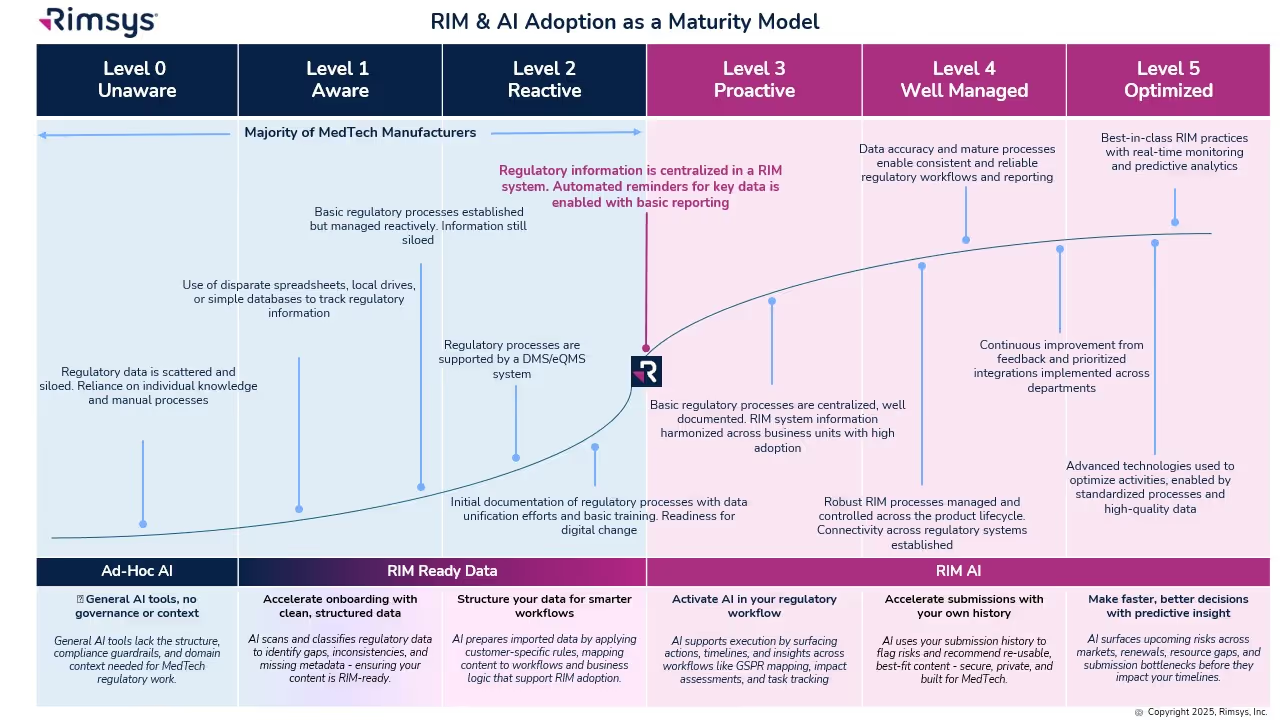
While the space is growing quickly, regulatory information management (RIM) systems are still relatively new to a lot of medtech companies. RIM systems help companies digitize and automate regulatory activities associated with their products. They provide a central information repository for all regulatory content and streamline activities like market registrations, data capture and transmission of unique device identification (UDI), and building essential principles tables while tracking associated standards.
Given that many regulatory affairs teams still manually manage these processes through complex spreadsheets and disjointed documents, the value of an automated solution is pretty obvious, but quantifying that value—especially for teams that aren’t seasoned software acquirers—can be a bit harder. This guide provides a framework for regulatory affairs teams to quantify the potential benefits of a RIM system, and build an internal business case for investment.
Challenges with the traditional approach to regulatory affairs
While functional, there are a number of painful inefficiencies that come along with traditional approaches to regulatory processes. Without an automated way to keep track of all the information and supporting documents associated with these processes, companies struggle with:
- Lack of visibility into regulatory data, clearance/approval status for different markets, and time-to-market metrics
- Compliance gaps driven by disconnects between go-to-market, distribution, and regulatory affairs teams
- Difficulty assessing the impact of, and responding to changes in standards or regulations
- Accumulation of “tribal” knowledge among individuals that limits continuity and visibility across the organization
These pains represent specific costs to MedTech companies in the form of:
- Staffing: Companies must over-staff regulatory affairs teams to support highly-manual processes. Expensive consultants are often brought in to help address in-house resource shortages.
- Productivity: Regulatory affairs teams lose huge amounts of time repeatedly hunting for information (up to 50% of their time spent).
- Lost revenue: Long application times and lack of process visibility delay market entry for new products. Non-compliance can lead to fines, or the need to pull products out of specific markets.
The automation and data consolidation/integration provided by a RIM system can significantly reduce these costs, and provide a clear, measurable return on investment.
Additional benefits of a RIM system
In addition to the addressing the pains outlined above, RIM systems can provide valuable benefits across MedTech companies:
- IT teams: Without a bespoke platform to manage regulatory processes, regulatory affairs teams rely on a broad collection of tools to support their day-to-day work. This can include specific software to create and manage UDIs and access regulatory intelligence, as well as use of software designed for other functions: enterprise resource planning (ERP), product lifecycle management (PLM), or quality management systems (QMS)—highly-configured to try and support regulatory activities. A comprehensive RIM system (like Rimsys) provides support for multiple regulatory functions, saving IT teams the cost of acquiring and maintaining separate systems. With functionality specifically designed for regulatory processes, a RIM system is easier to support than customizations to tools designed for other functions.
- Go-to-market teams: Sales and marketing organizations can also benefit from the adoption of a RIM system. In addition to bringing new solutions to market more quickly, RIM systems can also help with planning and forecasting. Visibility into the time and cost required to enter different markets, and the specific regulations associated with each market, can help go-to-market teams better prioritize target markets, and set revenue projections for their product lines. RIM systems can also provide workflows for project requests, allowing go-to-market teams to better coordinate registrations to support planned product launches.
- Distributors, in-country sponsors, and notified bodies: One-off email communications with external parties is not only time consuming for regulatory affairs teams, but inefficient for partners. RIM systems can provide controlled access for external parties, allowing them to login and directly access needed information without sending an email, and waiting (sometimes days) for a response. Streamlining these communications allows partner organizations to move more quickly, and ultimately accelerate the delivery of products into new markets. This helps to grow revenue while also improving the productivity of regulatory affairs teams who no longer have to interrupt their work for every internal or external information request.
Building your business case
Putting together the challenges and benefits outlined in the previous section (as applicable to your team), will feed the primary content of your business case. Next we’ll take a look at how to structure the content.
Part 1 – Your current situation and challenges
One of the best places to start when putting together a business case for a RIM system is to look at your current situation. What are the challenges that your organization faces? How much time is spent looking for information, submitting marketing applications, completing regulatory impact assessments, creating and maintaining the new MDR / IVDR GSPRs? How long does it take your team to complete new registrations? How well do internal teams communicate and coordinate go-to-market activities for new products and markets? How many products and countries does your team support today? What would happen if that number increased significantly?
Next, look at the business implications of the current situation. Does your team have a backlog of requests from go-to-market or other management teams? How often do you bring in external consultants to help with workload? Note the associated costs of your project backlog (delays in receiving market clearance), and the amount spent each year on consultants. Are there any other business risks such as continuity or non-compliance that are associated with your current approach? Does your team have the ability to identify regulatory roadblocks associated with markets you’re planning to enter?
Part 2 – Recommended solution
Here’s where you make the primary case for a RIM system. Highlight the specific capabilities and benefits of your solution of choice, and how it will address the challenges of your current situation. Highlight areas where other teams will benefit from the solution, and opportunities to drive greater organizational alignment.
Part 3 – Costs and expected ROI
Estimating costs and returns can be difficult, but it’s one of the key ways to improve the credibility of your business case. If you’re unsure about costs you can generally assume that a full-featured RIM system will cost the equivalent of 1 to 3 full-time regulatory affairs professionals, and use that as a starting point.
When calculating returns start with time-savings. If regulatory activities could be completed 50% more efficiently, how would that impact the number of consulting hours you use or hiring plans? If you could reduce pre-market clearance time by 6 weeks, how much additional revenue could be generated? Have you had instances where you incurred fines or had to remove products from a market due to compliance issues (i.e. shipping to markets where the product hasn’t been approved)? What were the associated costs?
Next, look at what your RIM system is replacing. Do you have individual tools for UDI or other functions that could be replaced? What about other tools? Does your team have seats in ERP or QMS tools that won’t be needed any more? All of these are relevant cost savings. In most cases, a RIM system will show strong ROI once you’ve estimated all of these savings.
Part 4 – Alternatives
Here’s where you want to demonstrate that you’ve done your due diligence in support of your recommendations. Have you evaluated multiple software solutions? Enumerate the specific capabilities or approach that led you to recommend your preferred vendor. Are there other ways to address your current challenges: expanding the regulatory affairs team, or implementing other types of software (rather than a RIM system)? Explain why you think these solutions will be less effective.
Putting it together
RIM systems can provide significant benefits specifically to regulatory affairs teams and broadly across MedTech companies. With a bit of legwork, it’s easy to put together a compelling case for investment in a solution. What can sometimes lead to difficulty in quantifying potential benefits—the fact that many MedTech companies don’t have a robust measurement framework for Regulatory affairs processes—means that you’ll be in a much better position to assess the performance of your team and impact of your investment once the analysis is complete.
Ready to get started? Download our RIM business case template. Questions? Our team is happy to work through the process with you and validate your estimates based on the experiences of our clients.
Similar posts







.avif)


